
corrosion stainless stainless steels and alloys
Corrosion stainless stainless steels and alloys
Stainless steels and alloys are materials that, as the name implies, have high resistance to corrosion. This means that they are not so easy to rust and destroy under the influence of moisture, oxygen and other aggressive environments. They play a key role in many areas of our lives, from kitchen utensils to the most difficult technical systems. Imagine how it is important that your knife remains sharp and does not deteriorate over the years, or that the details of the spaceship do not succumb to destruction in the rigid conditions of the cosmos. That is why stainless steels and alloys are so in demand.
Varieties and features
Different types of stainless steels and alloys have different characteristics of resistance to different types of corrosion. Some perfectly resist the effects of acids, others - salts, and others - aggressive chemicals. This is achieved thanks to certain elements that are included in the alloy. For example, chrome is one of the key components that create a protective film on the surface that prevents oxidation. Different combinations of chromium, nickel, molybdenum and other elements give us a variety of stainless steels, each with its own unique properties.
Application in everyday life
Stainless steels are used in a wide range of applications. We can find them in household appliances (for example, in refrigerators and dishes), in medical equipment (in surgical tools and prostheses), in construction (in structures resistant to an aggressive environment), as well as in the chemical industry (for equipment in contact with aggressive chemicals). In general, stainless steels ensure the durability and reliability of many objects and systems that we encounter every day.
The future of stainless steels
Modern research tends to create new types of stainless steels and alloys with even greater corrosion resistance and increased mechanical characteristics. Developments are aimed at creating materials that will be even more resistant to various aggressive environments, as well as light and durable. The use of such innovative materials is the path to more effective, durable and safe technologies in the future. For example, this can be the creation of more effective wind turbines, more durable and light design of aircraft, etc.
AppropriateProducts
Corresponding products
The best soldproducts
The best -selling products-
 Alloy Incola 825 (N08825)
Alloy Incola 825 (N08825) -
 Duplex steel 2205 (F60)
Duplex steel 2205 (F60) -
 High -temperature bearing steel G102CR18MO (9CR18MO)
High -temperature bearing steel G102CR18MO (9CR18MO) -
 Alloy Monel 400 (N04400)
Alloy Monel 400 (N04400) -
 Dispersion-hardening stainless steel 630 (17-4ph)
Dispersion-hardening stainless steel 630 (17-4ph) -
 (Super) High -strength steel A100
(Super) High -strength steel A100 -
 Alloy Inconel 625 (N06625)
Alloy Inconel 625 (N06625) -
 Histella alloy C-276 (N10276)
Histella alloy C-276 (N10276) -
 Superfisted stainless steel 316L-uhp-a
Superfisted stainless steel 316L-uhp-a -
 Austenitic stainless steel n08367
Austenitic stainless steel n08367 -
 HH4169 frying alloy (in718)
HH4169 frying alloy (in718)





